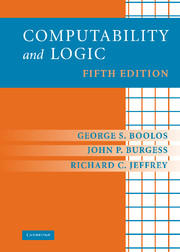Book contents
- Frontmatter
- Contents
- Preface to the Fifth Edition
- COMPUTABILITY THEORY
- BASIC METALOGIC
- FURTHER TOPICS
- 19 Normal Forms
- 20 The Craig Interpolation Theorem
- 21 Monadic and Dyadic Logic
- 22 Second-Order Logic
- 23 Arithmetical Definability
- 24 Decidability of Arithmetic without Multiplication
- 25 Nonstandard Models
- 26 Ramsey's Theorem
- 27 Modal Logic and Provability
- Annotated Bibliography
- Index
27 - Modal Logic and Provability
Published online by Cambridge University Press: 05 June 2012
- Frontmatter
- Contents
- Preface to the Fifth Edition
- COMPUTABILITY THEORY
- BASIC METALOGIC
- FURTHER TOPICS
- 19 Normal Forms
- 20 The Craig Interpolation Theorem
- 21 Monadic and Dyadic Logic
- 22 Second-Order Logic
- 23 Arithmetical Definability
- 24 Decidability of Arithmetic without Multiplication
- 25 Nonstandard Models
- 26 Ramsey's Theorem
- 27 Modal Logic and Provability
- Annotated Bibliography
- Index
Summary
Modal logic extends ‘classical’ logic by adding new logical operators ▪ and ♦ for ‘necessity’ and ‘possibility’. Section 27.1 is an exposition of the rudiments of (sentential) modal logic. Section 27.2 indicates how a particular system of modal logic GL is related to the kinds of questions about provability in P we considered in Chapters 17 and 18. This connection motivates the closer examination of GL then undertaken in section 27.3.
Modal Logic
Introductory textbooks in logic devote considerable attention to a part of logic we have not given separate consideration: sentential logic. In this part of logic, the only nonlogical symbols are an enumerable infinity of sentence letters, and the only logical operators are negation, conjunction, and disjunction: ∼,&,∨. Alternatively, the operators may be taken to be the constant false (⊥) and the conditional (→). The syntax of sentential logic is very simple: sentence letters are sentences, the constant ⊥ is a sentence, and if A and B are sentences, so is (A → B).
The semantics is also simple: an interpretation is simply an assignment ω of truth values, true (represented by 1) or false (represented by 0), to the sentence letters. The valuation is extended to formulas by letting ω(⊥)=0, and letting ω(A → B) = 1 if and only if, if ω(A) = 1, then ω(B) = 1. In other words, ω(A → B) = 1 if ω(A) = 0 or ω(B) = 1 or both, and ω(A → B) = 0 if ω(A) = 1 and ω(B) = 0.
- Type
- Chapter
- Information
- Computability and Logic , pp. 327 - 340Publisher: Cambridge University PressPrint publication year: 2007



